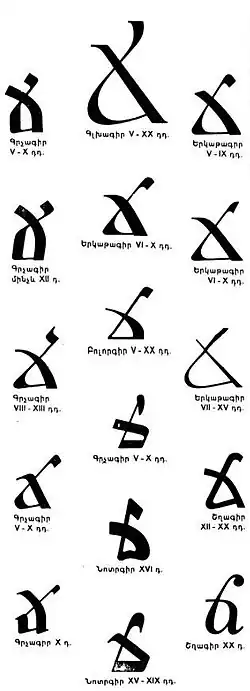Che, or Če (majuscule: Ճ; minuscule: ճ; Armenian: ճե; Classical Armenian: ճէ) is the nineteenth letter of the Armenian alphabet. It represents the voiceless palato-alveolar affricate (/t͡ʃ/) in standard Eastern Armenian, and the voiced palato-alveolar affricate (/d͡ʒ/) in western varieties of Armenian. Created by Mesrop Mashtots in the 5th century, it has a numerical value of 100.[1] Its shape is visually similar to the Cyrillic letter, Be (б). Its shape in lowercase form is also similar to the minuscule form of the Latin letter B (b).
Gallery
 Various historic fonts
Various historic fonts -
-
-
Bolorgir
-
Notrgir
-
Shghagir
-
Typographic form
-
Handwritten form
Computing codes
Character information | Preview | Ճ | ճ |
| Unicode name | ARMENIAN CAPITAL LETTER CHEH | ARMENIAN SMALL LETTER CHEH |
| Encodings | decimal | hex | dec | hex |
| Unicode | 1347 | U+0543 | 1395 | U+0573 |
| UTF-8 | 213 131 | D5 83 | 213 179 | D5 B3 |
| Numeric character reference | Ճ | Ճ | ճ | ճ |
See also
References
External links
- Ճ on Wiktionary
- ճ on Wiktionary


.svg.png) Rounded Erkat'agir
Rounded Erkat'agir Angular Erkat'agir
Angular Erkat'agir.svg.png) Bolorgir
Bolorgir Notrgir
Notrgir.svg.png) Shghagir
Shghagir Typographic form
Typographic form Handwritten form
Handwritten form